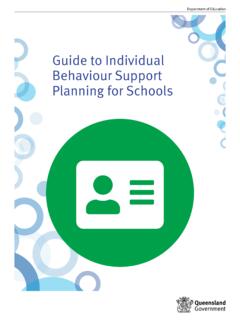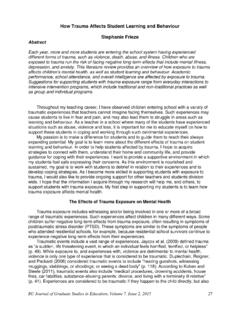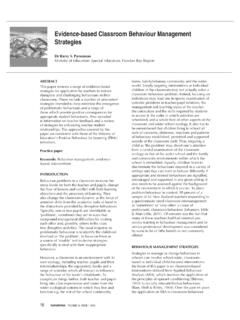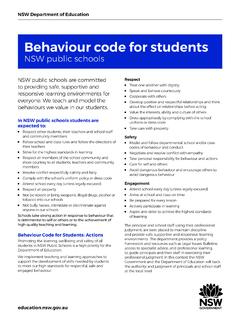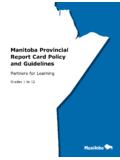Transcription of Guide to functional behaviour assessment for schools
1 Guide to functional behaviour assessment for schools compress-arrows-alt sync-alt Table of contents What is functional behaviour assessment (FBA)? .. 3. What is the purpose of this Guide ? .. 3. What is included in the Guide ? .. 3. Terminology .. 4. Overview of the FBA process.. 5. Who can conduct an FBA?.. 5. Is an FBA needed?.. 5. When to conduct an FBA.. 5. Functions of behaviour .. 6. Common functions .. 6. Determining the function of behaviour .. 7. Steps in FBA.. 8. 1. Identify and prioritise problem behaviour (s).. 8. 2. Collect baseline data.. 9. 3. Review records to determine impacting factors and previous interventions.. 9. 4. Interview parents, teachers, student and other relevant stakeholders .. 9. 5. Conduct direct observation(s) of the student .. 11. 6. Develop a summary statement .. 12. 7. Select interventions and develop the IBSP .. 12. Appendix 1: Identifying the behaviour .. 13. Problem behaviour Inventory.
2 13. Appendix 2: Indirect data collection forms.. 15. functional assessment Interview Tool (FAIT).. 15. Student Interview Form.. 18. Family Interview Form.. 20. functional assessment Checklist for Teachers and Staff (FACTS).. 22. Summary of behaviour ..24. Appendix 3: Direct data collection forms .. 25. Event Tally Form.. 25. Scatter Plot Form .. 26. ABC Form.. 27. ABC Recording Form.. 28. Page 2 of 30. What is functional behaviour assessment (FBA)? functional behaviour assessment (FBA) is a process for collecting information to help determine why problem behaviour occurs and to serve as a basis for the development of an individual behaviour support plan (IBSP). Research1 has shown that interventions developed from an FBA are more likely to be effective in reducing rates of problem behaviour . FBA aims to: compress-arrows-alt sync-alt Define behaviour in Determine what aspects Identify the specific, observable and of the environment or consequences which measurable terms situation contribute maintain the towards the behaviour behaviour What is the purpose of this Guide ?
3 This Guide has been developed as a reference for school teams; it does not take the place of FBA training. schools can use this Guide as a checklist to ensure that all steps in the FBA process are followed, or as an introduction to what is involved in conducting a school-based FBA. schools can also access the online FBA tool to work through a simple FBA process. What is included in the Guide ? This Guide provides an overview of terminology and the steps in the FBA process. Templates are provided in appendices. 1 Ervin, , Radford, , Bertsch, K., Piper, , Ehrhardt, , & Poling, A. (2001). A descriptive analysis and critique of the empirical literature on school-based functional assessment . School Psychology Review. 30, 193 210. McIntosh, K., Brown, J. A., & Borgmeier, C. J. (2008). Validity of functional behaviour assessment within a Response to Intervention framework: Evidence, recommended practice, and future directions. assessment for Effective Intervention, 34(1), 6 14.
4 Walker, V. L., Chung, Y. C., & Bonnet, L. K. (2018). Function-based intervention in inclusive school settings: A meta-analysis. Journal of Positive behaviour Interventions, 20(4), 203 216. Page 3 of 30. Terminology Term Definition Example Antecedent An antecedent is an event that elicits or Teacher says Take out your maths book'. triggers the problem behaviour . Alternative The alternative behaviour is what we want Kali is taught to ask for a motor break instead behaviour the student to do instead of the problem of walking around the room. behaviour . The alternative behaviour must fulfil the same function as the problem behaviour and be easy for the student to do. behaviour The behaviour is the specific, observable Kali wanders around the classroom touching and measurable problem behaviour . other students ' belongings during work time. Consequence A consequence is an event or response that Other students giggle when Bobby calls out.
5 Happens immediately after the problem behaviour and which maintains or reinforces a problem behaviour . Function The function of a behaviour is the purpose of Kali walks around the room to avoid the maths the behaviour . When we think functionally, work; Bobby calls out to access peer attention. we ask why the behaviour occurs. Hypothesis The hypothesis is our best guess as to We hypothesise that Kali walks around the why the problem behaviour is occurring. room to avoid doing the maths work. The summary statement forms the basis for the hypothesis. Reinforcement Reinforcement is any action or event that The student is given a preferred activity increases the likelihood of the behaviour (positive reinforcement); the student is sent being repeated. Reinforcement can be out of the classroom (negative reinforcement). positive (something is presented as a result of the behaviour ) or negative (something undesirable is taken away as a result of the behaviour ).
6 Setting event Setting events are situations which either Kali has had an argument with a sibling that intensify or increase the likelihood of the morning; the parent has run out of medication problem behaviour . for Bobby. Summary A summary statement succinctly describes When Kali has had an argument with her statement the relationship between observed events brother before school (setting event) and the and the problem behaviour . teacher presents a maths task that she thinks is too hard (antecedent), she will get up and wander around the classroom touching peers'. belongings ( behaviour ) for several minutes before the teacher asks her to return to her seat (consequence) because she can avoid doing the maths activity (function). Page 4 of 30. Overview of the FBA process The major steps in FBA are: 1. Identify and prioritise problem behaviour (s). 2. Collect baseline data. 3. Review records to determine impacting factors and previous interventions.
7 4. Interview parents, teachers, student and other relevant stakeholders. 5. Conduct direct observation(s) of the student. 6. Summarise information and develop a hypothesis. Using the FBA: 1. Select interventions and develop the IBSP. 2. Implement the IBSP. 3. Continue monitoring and data collection. 4. Make adjustments to the IBSP, as needed. Who can conduct an FBA? No specialist qualifications are required to conduct an FBA in schools . Most FBAs can be conducted by a school- based team, guided by a behaviour specialist or a team member trained in conducting FBAs. Is an FBA needed? Before investing time in conducting an FBA it is important to check that universal and classroom support is in place. When multiple students are experiencing academic or behavioural difficulties, schools should first focus on putting supports in place across the whole school and entire class. It may also be necessary to examine teacher-student interactions to ensure that the classroom environment is generally positive and that effective instruction and proactive classroom management are in place.
8 The following flowchart provides an overview of the conditions that should be in place before conducting an FBA. When to conduct an FBA. Check that the majority of the class is reaching Academic skills academic benchmarks Check that the majority of the class is following class Expectations in place rules and instructional time is maximised Check that teacher responses to problem behaviour are list-ol Continuum of responses consistent and respectful search Conduct FBA If behaviours persist when previous conditions are met Page 5 of 30. Functions of behaviour All behaviour serves a function, or purpose. The function can be either to access something or to avoid something (see diagram below). When students use a behaviour repeatedly, they are using the behaviour to access or avoid something in the immediate environment. behaviour user-plus Access user-times Avoid hand-rock Sensory user-friends Social cube Tangible/Activity Adult Peer Common functions In schools there are usually some common functions for student behaviour .
9 However, it is important to remember that sometimes a behaviour can fulfil more than one function for a student, depending on the context. Common access' functions Common avoid' functions To get a toy or tangible To escape from an activity To gain access to an activity To avoid a demand To get attention from an adult To get away from peers To get attention from peers To avoid an unpleasant sensation To get sensory stimulation To avoid an adult Page 6 of 30. Determining the function of behaviour A hypothesis about the function of a behaviour is arrived at only after seeing repeated patterns of behaviour . Patterns are identified through collecting and summarising data about the problem behaviour . Information needs to be collected on the setting events and antecedents that precede the behaviour , and the consequences that reliably follow the problem behaviour . The student support team needs to collect sufficient information to be confident that the hypothesised function is accurate.
10 Read the example below and have a go at hypothesising the function of Ziggy's behaviour . Antecedent behaviour Consequence information collected from records/ Ziggy backchats when given an information collected from interview/observation instruction and argues when records/interview/observation directed to a set task in core subject areas. Teacher directs class to write a This sucks. Teacher waits and scans. short answer in their notebooks. Teacher quietly asks Ziggy to start I have a sore hand. Why do you Teacher moves away. work. always give us so much writing? . Teacher asks students to read out Mutters She better not ask me. Teacher ignores comment. their responses. Teacher asks Ziggy how she is I don't know what to do. You never Teacher stays and helps Ziggy going with the next task. help me. get started. Teacher asks, How are you going? Stop checking on me. I'm doing Teacher moves away. the work! . In the example provided we can see that on 4 out of 5 occasions Ziggy's backchatting behaviour resulted in her being left alone by the teacher.
